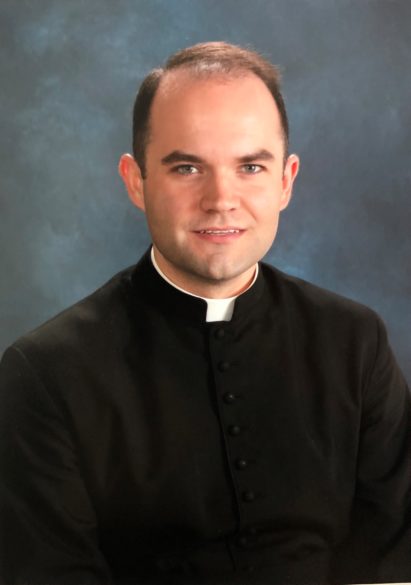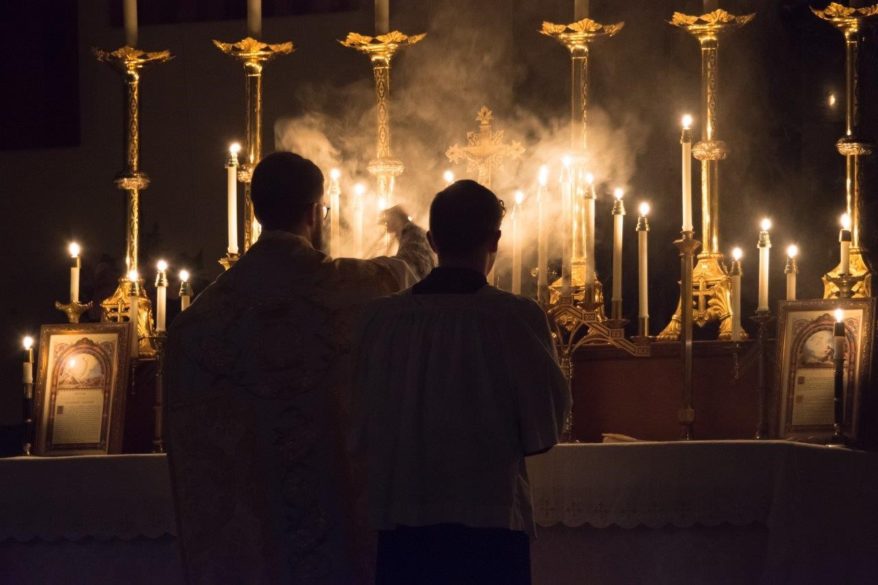
SPIRIT AND TRUTH
By Father Aaron Williams
Early on the morning of Dec. 7, I offered Mass at St. Jude Pearl for a small group of people so we could take part in a old, but less well-known Advent tradition. On Saturdays in Advent, it has been customary in some places to offer a Mass of the Blessed Virgin Mary early in the morning before dawn and entirely by candlelight. This has come to be known as a ‘Roráte’ Mass — taken from the words of the Entrance Antiphon: Roráte cæli desúper et nubes pluant justum (Drop down dew, you heavens, from above, and let the clouds rain down righteousness).
The liturgical year often makes good use of the natural seasonal movements of the earth. The summer solstice occurs just before the feast of St. John the Baptist (June 24), while the winter solstice falls right before Christmas day. On the summer solstice each year, the days begin to grow shorter as we receive less and less light until the winter solstice when the days begin to grow longer. If we compare this natural occurrence with the two feast days that fall near those days, a symbolic meaning comes forward.
After St. John baptized our Lord, his followers came to him and said, “Rabbi, he who was with you beyond the Jordan, to whom you bore witness, here he is, baptizing, and all are going to him.” And John said to them, “He must increase, but I must decrease” (John 2:26,30). Jesus Christ revealed himself to be the Light of the World, and so it is only fitting that when we reach the feast day of his Birth, that the amount of sunlight we receive each day grows longer and longer.
By offering Mass in total darkness in these last days before Christmas, the interplay of light and darkness in the church building can further underscore this feeling of longing for the Messiah — especially when the Mass is timed just right so that the Sun rises toward the end of the Mass. Something special happens when you are standing in a dark church hearing all those readings which prophecy a Messiah and then right around the time for Holy Communion light is beginning to fill the church from outside through the windows. You no longer need to hold a candle, for instance, so you can read from the hymnal. Saint Augustine makes reference to this symbolism in one of his sermons, “Let us celebrate this day as a feast not for the sake of this sun, which is beheld by believers as much as by ourselves, but for the sake of him who created the sun.”
Though the custom in the United States was to offer these Masses on Saturdays of Advent when the Mass texts was taken from the votive Masses of the Blessed Virgin Mary, other similar customer exist elsewhere. In the Philippines there is a tradition, dating at least to the 16th century of offering “Misa de Aguinaldo” (‘Gift Mass’). Each day from Dec. 16 to Dec. 24 the daily Mass is traditionally offered before dawn and entirely by candlelight. The same custom exists in some Latin American cultures under the name of “Misa de Gallo” (‘Rooster Mass’). These daily masses occur each day until Christmas when it is called the “Misa de los Pastores” (Mass of the Shepherds).
The custom of offering these Advent and Christmas Masses during the night hours is recorded as early as the 4th century by Egeria — a Galician historian who traveled to the Holy Land particularly to record the way in which Christians celebrated the liturgical year in Jerusalem. She writes that on the night before Christmas, it was custom in Jerusalem for the people to process through the streets with torches and candles leading to a dark church where Mass was celebrated before dawn. Pope Sixtus III was inspired by this tradition and instituted the first celebration of the ‘midnight’ Christmas Mass at St. Mary Major Basilica in Rome.
Roráte masses may be offered with or without music, on any day when it would be acceptable for the people to gather at an early hour. If a parish wanted to preserve the tradition as it was kept in America, the Votive Mass of the Blessed Virgin Mary for Advent as found in the Roman Missal could be used. Because there is little light, parishes could use commonly memorized songs such as ‘O Come, O come, Emmanuel’ — which can even be sung without instruments both for the ease of musicians who might have difficulty playing in the dark, but also to further underscore the anticipation of the season.

Silence is also another important element to these Masses. Silence denotes an expectation of sound, while darkness denotes the expectation for light. And, because enough light needs to be present on the altar for the priest to read the missal, those who decorate the sanctuary should make use of whatever candlesticks and candelabra the parish has available. These many lights add to the beauty of the celebration and help emphasize the altar as a common center for worship.
